The hammeri plant, also known as Tillandsia hammeri, is a unique and beautiful species of air plant that has captured the hearts of many plant enthusiasts. But where did this plant come from, and how did it become so popular? In this article, we’ll take a deep dive into the history of the hammeri plant and explore its journey from its discovery to its current popularity.
The Discovery of the hammeri plant
The hammeri plant was first discovered in the early 1900s by a botanist named Dr. Walter Till. Dr. Till was exploring the forests of Ecuador when he stumbled upon a small, epiphytic plant with long, thin leaves and vibrant purple flowers. He collected a specimen and brought it back to his lab for further study.
After careful examination, Dr. Till determined that this plant was a new species and named it after himself, Tillandsia hammeri. The plant was then classified as a member of the Bromeliaceae family, which includes other popular air plants like Tillandsia ionantha and Tillandsia xerographica.
The Characteristics of the hammeri plant
The hammeri plant is a unique species of air plant that has several distinct characteristics. It has long, thin leaves that can grow up to 12 inches in length and are covered in tiny, silvery scales. These scales help the plant absorb moisture and nutrients from the air, making it an ideal epiphyte.
The plant also produces vibrant purple flowers that bloom in the spring and summer months. These flowers are a favorite among pollinators, making the hammeri plant an important part of the ecosystem.
The Rise in Popularity
For many years, the hammeri plant remained relatively unknown outside of the scientific community. However, in the 1980s, the plant began to gain popularity among plant collectors and enthusiasts.
One of the main reasons for this rise in popularity was the increasing interest in air plants as houseplants. Air plants are low-maintenance, making them a perfect choice for busy individuals who still want to enjoy the beauty of plants in their homes. The unique appearance of the hammeri plant also made it a desirable addition to any plant collection.
The Role of Social Media
The rise of social media also played a significant role in the popularity of the hammeri plant. With the rise of platforms like Instagram and Pinterest, plant enthusiasts were able to share photos of their collections and showcase the beauty of the ham meri plant to a wider audience.
As more and more people became interested in air plants, the demand for the ham meri plant increased. This led to an increase in production and availability of the plant, making it more accessible to the general public.
The hammeri plant Today
Today, the hammeri plant is a popular choice among plant enthusiasts and is widely available in nurseries and online stores. Its unique appearance and low-maintenance nature make it a favorite among beginners and experienced plant owners alike.
The Benefits of the hammeri plant
Aside from its aesthetic appeal, the ham meri plant also offers several benefits to its owners. As an air plant, it does not require soil to grow, making it a versatile addition to any home. It also helps improve air quality by absorbing pollutants and releasing oxygen into the air.
The hammeri plant is also a great choice for those looking to add a touch of greenery to small spaces. Its compact size and ability to thrive without soil make it a perfect choice for terrariums, hanging planters, and other small containers.
Caring for Your hammeri plant
Caring for a hammeri plant is relatively easy, making it a great choice for beginners. Here are some tips to help you keep your hammeri plant healthy and thriving:
- Water your plant once a week by misting it with water or soaking it in a bowl of water for 20-30 minutes.
- Place your plant in a bright, indirect light. To prevent leaf burn, it is advisable to stay away from direct sunlight.
- Apply a diluted liquid fertilizer to your plant on a monthly basis.
- Keep your plant in a well-ventilated area to prevent the buildup of moisture, which can lead to rot.
Conclusion
The hammeri plant has come a long way since its discovery in the early 1900s. From being a relatively unknown species to becoming a popular choice among plant enthusiasts, this unique air plant has captured the hearts of many.
With its striking appearance and low-maintenance nature, the hammeri plant is sure to continue its rise in popularity and remain a favorite among plant lovers for years to come. So why not add one to your plant collection and see for yourself why the hammeri plant is so beloved?
For more information, visit: Apzo Media







